United Airlines announced on Sunday (January 5) that it will begin testing Elon Musk’s Starlink satellite internet system for in-flight connectivity starting in February. The airline plans to introduce the service on commercial flights operated by its Embraer E-175 aircraft by spring 2025. This marks the beginning of United’s roll-out of Starlink, which aims to provide internet services across its entire regional fleet by the end of 2025.
Expansion of Starlink services
United Arlines‘ statement revealed that the airline intends to equip its two-cabin regional aircraft with Starlink connectivity, with the first fully Starlink-enabled plane expected to be operational on major routes by the end of this year. The long-term goal is to offer Starlink connectivity on all United flights.
Changes to free wi-fi offer
While United had previously announced plans to offer free Wi-Fi for all passengers, the airline has revised its strategy. Now, access to the Starlink-powered internet will be free exclusively for MileagePlus members, marking a shift from its earlier plan to offer complimentary Wi-Fi to all travelers.
Strategic partnership with Starlink
United’s deal with Starlink, a unit of SpaceX, was signed last year and will provide in-flight internet services across the airline’s fleet of over 1,000 aircraft in the coming years. The move is part of Starlink’s broader strategy to expand its satellite-based internet services beyond rural consumers and households, having already inked agreements with Hawaiian Airlines and regional carrier JSX.
With Starlink now set to take off across United’s fleet, the collaboration underscores the growing shift toward satellite internet in the aviation industry, aiming to enhance the in-flight experience for passengers.
What is Starlink satellite internet
Starlink satellite internet is a satellite-based broadband internet service developed by SpaceX, the aerospace company founded by Elon Musk. It uses a constellation of low Earth orbit (LEO) satellites to provide high-speed internet access, particularly in remote and underserved areas where traditional internet infrastructure, such as fiber-optic cables or cellular networks, is limited or unavailable.
The Starlink system operates by using small satellites orbiting Earth to transmit signals to user terminals on the ground, which are typically small satellite dishes installed at homes, businesses, or vehicles. These satellites provide a faster and more reliable internet connection compared to traditional satellite services, which often suffer from higher latency and slower speeds due to their positioning in higher orbits.
Starlink aims to improve global internet access, especially for people in rural or difficult-to-reach regions, and has expanded to offer services to various industries, including airlines, with plans to connect aircraft in-flight, as seen with United Airlines’ recent partnership.

